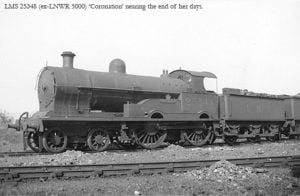Our focus for this week’s Project Information is on the construction of No. 2013 “Prince George”, which the LNWR George The Fifth Steam Locomotive Trust is undertaking.
2013 “Prince George”, once completed, will be the 91st member of the London and North Western Railway (LNWR) designed “George the Fifth”Class.
The usual Project Information Layout will follow, firstly looking into the Background of this lost class, the Aim of the LNWR George The Fifth Steam Locomotive Trust and the Progress they have made to date.
If you missed last week’s Project Information, you can read it here
Background
When Bowen-Cooke became Chief Mechanical Engineer (CME) of the LNWR in 1909, he set about improving the fleet of locomotives from his predecessors. The most notable improvement included into some of his designs was the use of Superheating. The practice of Superheating had originated in Germany, when Wilhelm Schmidt designed his Schmidt-Type Superheater.
Many CMEs in England were keen to try this new improvement. This is the most significant change between Bowen-Cooke’s Predecessor’s Class of 4-4-0, the “Whale Precursor” Class and his own “George the Fifth” Class. The majority of the Class was built from scratch, but 10 were rebuilt from locomotives previously apart of the “Queen Mary” Class.
All 90 members of the class, including the rebuilds, were completed between 1910 and 1915. The first member of the class was named “George The Fifth”, this becoming the name of the class, like many other classes on the LNWR. Both Names and Numbers were retained from locomotives withdrawn at the time each new George The Fifth was completed. This caused the numbering of the class to appear in a random order.
Performance
The George the Fifths were designed to haul the heaviest and fastest Passenger Express Trains on the LNWR. They had roughly 25% more power than the Whale Precursors, making them very suitable replacements. They held this Top Link until bigger locomotives, of the 4-6-0 wheel arrangement surpassed them.
Decline and Withdrawal
Only a few years after 2663 “George the Fifth” had been completed at Crewe Works, Bowen-Cooke produced his large 4-6-0, the “Claughton” Class. As the Claughtons were bigger and had more power, they were put onto the heaviest and fastest Express Passenger Trains. Despite this, the George the Fifths still hauled many Express Passenger duties. It was under London, Midland and Scotland Railway (LMS) ownership that all the George the Fifths were downgraded to Secondary duties.

There was two main reasons for the decline of the George the Fifths under LMS ownership, the first being the engines themselves. by the late 1920s, many were fast approaching 20 years of age. Although still capable Engines, this age, as well as their Power Classification of 3P meant they were suited for Secondary duties, were trains were lighter and easier timings.
The second reason being Ex-Midland Railway Policies influencing LMS Polices more than EX-LNWR Polices. The effect of this on the George the Fifth class was being downgraded to Secondary duties sooner than if the LNWR hadn’s been absorbed into the LMS.
1933 saw the first class member withdrawn, this being No. 1628 “Foxhound”. Majority of the class were withdrawn by 1940, with only 3 surviving into British Railway ownership. This didn’t last long, with the last class member being withdrawn in May 1948, which was No. 868 “India”. Unfortunately, the Preservation Movement was not big in the late 1940s, leading to no George the Fifths being Preserved.
Aim of the LNWR George The Fifth Steam Locomotive Trust
The main aim of the Trust is to build the 91st member of the George the Fifth class, with the possibility of Mainline running.
Choosing which locomotive to represent the LNWR was a hard decision to make. Originally, the Precursor class was chosen to be built. This being due to them setting the trend for the LNWR’s locomotive development in the 20th century. They were also a much needed replacement for the ageing fleet Wale inherited from Webb. This is where the Trust felt the George the Fifth class was actually more representative of the LNWR, as they featured Wale’s basic design, but with modifications made by Bowen-Cooke.
With New Builds such as Tornado being completed, the Trust felt if a big complex locomotive can be finished, then the smaller less-complex George the Fifth would be more than capable of being built by the Trust.
The Trust have decided to Number and Name the new George the Fifth No. 2013 “Prince George”. The Engine being named after Duke and Duchess of Cambridge’s son, Prince George, with the Number 2013 being the year the Prince was born.
Progress Made So Far
Good progress has been by the Trust to date. Components manufactured include Smokebox, Wheelsplasher and Whistle.
In the Trust last Newsletter, from January 2017, contain information on a few components. The first component mentioned is the Boiler. The original drawings the Trust had have been updated to meet all modern regulation standards. With the new drawings, the Trust was in talks with potential suppliers who could build the Boiler. To help raise finances for the Boiler, the Boiler Barrel Club was set up.
The completed Smokebox will be used for display purposes until eventually attached to the Locomotive’s Frame. The Smokebox has been to the Great Central Railway, with the public being able to view it. Funds have been raised to allow the order for both Coupling Rods to be placed. The order for both the Bogie Wheel cast and full height Chimney were placed shortly afterwards.
Once again we have come to the end of another Project Information. If you missed last week’s Project Information, you can read it here
If you are a fan of the BR Standard Classes, you won’t want to miss next week’s Project Information!
- Visit the George The Fifth Steam Loco Trust Website
For more information and to get involved